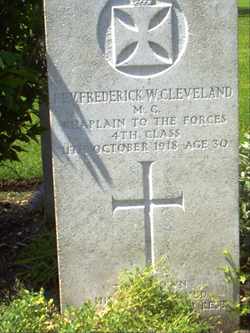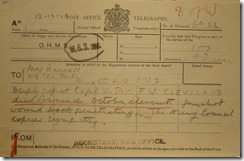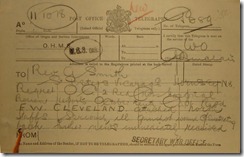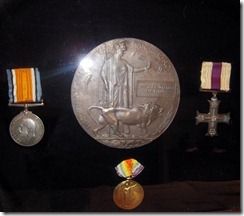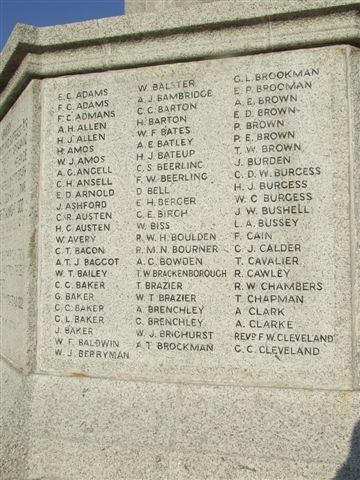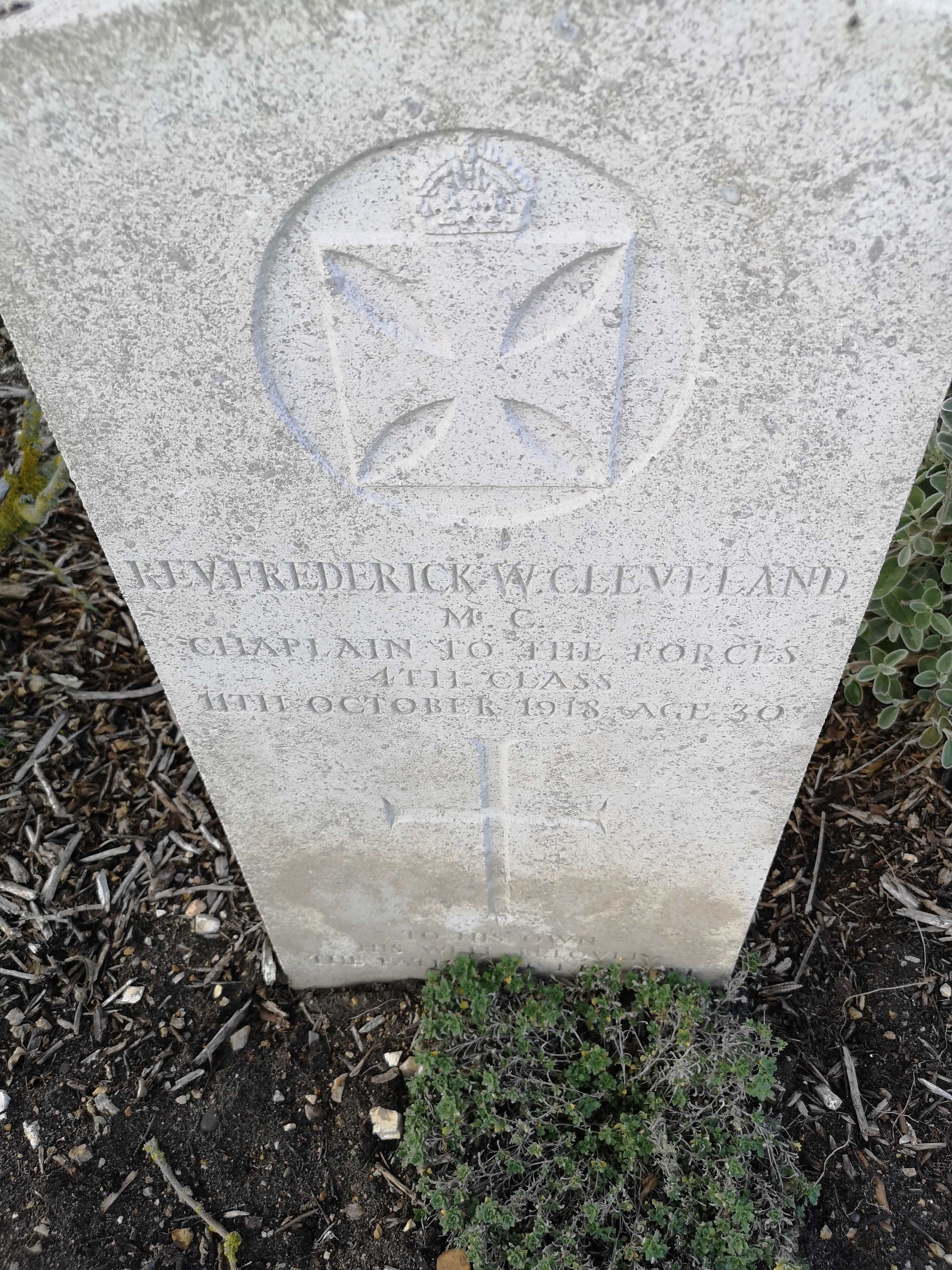He held the Military Cross and was Mentioned* in Despatches.
He was 30 and the son of the late Samuel George and Eliza Cleveland of Margate. He was born at 2 Coburg Place, Bayswater, London and Baptised on 15th March 1904 at Saint Mary Magdalene, Woolwich.
He studied at Mirfield and Lichfield Theological Colleges, until 1909, and at The University of Durham, where he obtained a Licentiate of Theology in 1911. He was made a Deacon in 1911 by the Bishop of Stafford.
Ordained Priest by the Bishop of Lichfield in 1913, he served his Title as Curate of Christ Church, Tunstall from 1911 until 1913, when he moved to Porthill, for Mission work in the Potteries, being based at St. Andrews Church. This is the time he would have spent with the Troop as its Chaplain.
He was Senior Curate at St. Peter's Hornsey, North London from 1915 (or 1913 according to some sources – unlikely) until 1916 when he became a Chaplain to the Forces 4th Class (Captain), attached 1/6th Battalion North Staffordshire Regiment.
He was a member of 1st Porthill Scout Troop and there is an on-line memorial to him (and the rest of the members of that Troop killed in wars) here -
http://remember.porthillscouts.org.uk/site/the-men/rev-frederick-walter-cleveland-mc/
The photo of him added by "wrig" was extracted from the above web site and a relative of Frederick,Tim Knaust.
The Staffordshire Weekly Sentinel
Saturday October 19 1918
Former Porthill Chaplain
Death From Wounds
In Action With North Midland Division
News has just received by the Vicar of St. Andrew's Porthill of the death from wounds received in action, of the Rev. Frederick Walter Cleveland, Chaplain of the Forces, formerly assistant priest at Porthill. He was badly wounded near Cambrai on October 3rd, and was removed to a Red Cross hospital at Rouen, where he passed away on Friday last.
Mr. Cleveland, after a theological training at Mirfield and Lichfield, was ordained deacon in 1911 and priest in 1913, his first curacy being at Christ Church, Tunstall. In 1913 he accepted the curacy of St. Andrew's, Porthill, with the special charge of the mission district of St. Wulstan, Longbridge, Hayes. He worked with very great zeal and enthusiasm and speedily made his mark in the parish, his influence over young people being very noticeable. At Longbridge, Hayes he brought about the renovation and adornment of the Mission Church, and, mainly owing to his exertions, an important addition was made to the buildings by the voluntary labour of the people. Early in 1915 he volunteered for service with the Army Chaplains' Department, but not until May 1916, after his departure from this district, was he called upon. Then he was attached to the local battalions of the 46th (North Midland) Division, and served continuously with them up until the time of his been wounded. He was as faithful and strenuous in his work as chaplain as he was a parish priest, and was popular and highly esteemed by both officers and men. He was due for leave at the end of September, but owing to a shortage of Church of England chaplains with his division, and knowing that his men were due to go into action, he generously gave up his leave and allowed one of the Nonconformist chaplains to take his turn. He went into action in the fighting in which the North Midland Division distinguished itself recently, and there he received his death wound. His death, at the age of 30, will be lamented by the Church of which he was a faithful priest and by his many friends and spiritual children in this district.
When the details of his will were published, he was listed as living at 56 Lausanne Road, Hornsey, Middlesex. His estate was managed by his sister Constance and he left £229 2s 8d .
From his army record comes the information that amongst his effects that were returned to his sister, were his crucifix and stand (which had been damaged), a communion book, an altar cloth, a pipe & tobacco, 3 lead pencils and his false teeth!
He is remembered on the Porthill Memorial, the Margate War Memorial and the Aldershot Memorial.
1.Some information courtesy of his great niece Janet Barber.
2.Some information courtesy of Museum of Army Chaplaincy ↩
3.Sentinel article courtesy of Geoff Mayer ↩
4.Photos of Fr. Cleveland in uniform courtesy of his great great nephew Tim Knaust.
5.Photos of Fr. Cleveland's medals courtesy of his great great nephew Tim Knaust
Births Mar 1888 CLEVELAND Frederick Walter Paddington 1a 70
The Citation for the award of the Military Cross read:
"During the taking of the St Quentin Canal, on 29th September 1918, and later, during the advance on Doons Hill, he rendered invaluable assistance. He was with the second wave, and dressed a number of bad cases, and as soon as the first objective was reached, he assisted back to the aid post large numbers of men. He was wounded by shell-fire in the back on 4th October. He showed great gallantry and devotion to duty."
* Mentioned in Despatches (or Dispatches) (MID) is one whose name appears in an official report written by a superior officer and sent to the high command, in which is described the soldier's gallant or meritorious action in the face of the enemy. In a number of countries, a soldier's name must be mentioned in despatches as a condition for him to receive certain decorations. In the British Armed Forces, the despatch is published in the London Gazette. Soldiers of the British Empire or the Commonwealth of Nations who are mentioned in despatches but do not receive a medal for their action are nonetheless entitled to receive a certificate and wear a decoration. For 1914-18 and up to 10th August 1920, the decoration consisted of a spray of oakleaves in bronze. This decoration was only established in 1919, but it had retroactive effect. From 1920 to 1993, the decoration consisted of a single bronze oakleaf, and in the Canadian Forces still does. Even if the soldier is mentioned in despatches more than once, only a single such decoration is worn. In Britain, since 1993, the decoration is a single silver oakleaf. In each case the decoration is pinned or sewn diagonally on to the appropriate campaign medal ribbon. If no campaign medal is awarded, the oak leaf is worn on the left breast of the dress uniform. Prior to 1979, a Mention in Despatches was one of the few awards that could be made posthumously, the others being the Victoria Cross and George Cross.
He held the Military Cross and was Mentioned* in Despatches.
He was 30 and the son of the late Samuel George and Eliza Cleveland of Margate. He was born at 2 Coburg Place, Bayswater, London and Baptised on 15th March 1904 at Saint Mary Magdalene, Woolwich.
He studied at Mirfield and Lichfield Theological Colleges, until 1909, and at The University of Durham, where he obtained a Licentiate of Theology in 1911. He was made a Deacon in 1911 by the Bishop of Stafford.
Ordained Priest by the Bishop of Lichfield in 1913, he served his Title as Curate of Christ Church, Tunstall from 1911 until 1913, when he moved to Porthill, for Mission work in the Potteries, being based at St. Andrews Church. This is the time he would have spent with the Troop as its Chaplain.
He was Senior Curate at St. Peter's Hornsey, North London from 1915 (or 1913 according to some sources – unlikely) until 1916 when he became a Chaplain to the Forces 4th Class (Captain), attached 1/6th Battalion North Staffordshire Regiment.
He was a member of 1st Porthill Scout Troop and there is an on-line memorial to him (and the rest of the members of that Troop killed in wars) here -
http://remember.porthillscouts.org.uk/site/the-men/rev-frederick-walter-cleveland-mc/
The photo of him added by "wrig" was extracted from the above web site and a relative of Frederick,Tim Knaust.
The Staffordshire Weekly Sentinel
Saturday October 19 1918
Former Porthill Chaplain
Death From Wounds
In Action With North Midland Division
News has just received by the Vicar of St. Andrew's Porthill of the death from wounds received in action, of the Rev. Frederick Walter Cleveland, Chaplain of the Forces, formerly assistant priest at Porthill. He was badly wounded near Cambrai on October 3rd, and was removed to a Red Cross hospital at Rouen, where he passed away on Friday last.
Mr. Cleveland, after a theological training at Mirfield and Lichfield, was ordained deacon in 1911 and priest in 1913, his first curacy being at Christ Church, Tunstall. In 1913 he accepted the curacy of St. Andrew's, Porthill, with the special charge of the mission district of St. Wulstan, Longbridge, Hayes. He worked with very great zeal and enthusiasm and speedily made his mark in the parish, his influence over young people being very noticeable. At Longbridge, Hayes he brought about the renovation and adornment of the Mission Church, and, mainly owing to his exertions, an important addition was made to the buildings by the voluntary labour of the people. Early in 1915 he volunteered for service with the Army Chaplains' Department, but not until May 1916, after his departure from this district, was he called upon. Then he was attached to the local battalions of the 46th (North Midland) Division, and served continuously with them up until the time of his been wounded. He was as faithful and strenuous in his work as chaplain as he was a parish priest, and was popular and highly esteemed by both officers and men. He was due for leave at the end of September, but owing to a shortage of Church of England chaplains with his division, and knowing that his men were due to go into action, he generously gave up his leave and allowed one of the Nonconformist chaplains to take his turn. He went into action in the fighting in which the North Midland Division distinguished itself recently, and there he received his death wound. His death, at the age of 30, will be lamented by the Church of which he was a faithful priest and by his many friends and spiritual children in this district.
When the details of his will were published, he was listed as living at 56 Lausanne Road, Hornsey, Middlesex. His estate was managed by his sister Constance and he left £229 2s 8d .
From his army record comes the information that amongst his effects that were returned to his sister, were his crucifix and stand (which had been damaged), a communion book, an altar cloth, a pipe & tobacco, 3 lead pencils and his false teeth!
He is remembered on the Porthill Memorial, the Margate War Memorial and the Aldershot Memorial.
1.Some information courtesy of his great niece Janet Barber.
2.Some information courtesy of Museum of Army Chaplaincy ↩
3.Sentinel article courtesy of Geoff Mayer ↩
4.Photos of Fr. Cleveland in uniform courtesy of his great great nephew Tim Knaust.
5.Photos of Fr. Cleveland's medals courtesy of his great great nephew Tim Knaust
Births Mar 1888 CLEVELAND Frederick Walter Paddington 1a 70
The Citation for the award of the Military Cross read:
"During the taking of the St Quentin Canal, on 29th September 1918, and later, during the advance on Doons Hill, he rendered invaluable assistance. He was with the second wave, and dressed a number of bad cases, and as soon as the first objective was reached, he assisted back to the aid post large numbers of men. He was wounded by shell-fire in the back on 4th October. He showed great gallantry and devotion to duty."
* Mentioned in Despatches (or Dispatches) (MID) is one whose name appears in an official report written by a superior officer and sent to the high command, in which is described the soldier's gallant or meritorious action in the face of the enemy. In a number of countries, a soldier's name must be mentioned in despatches as a condition for him to receive certain decorations. In the British Armed Forces, the despatch is published in the London Gazette. Soldiers of the British Empire or the Commonwealth of Nations who are mentioned in despatches but do not receive a medal for their action are nonetheless entitled to receive a certificate and wear a decoration. For 1914-18 and up to 10th August 1920, the decoration consisted of a spray of oakleaves in bronze. This decoration was only established in 1919, but it had retroactive effect. From 1920 to 1993, the decoration consisted of a single bronze oakleaf, and in the Canadian Forces still does. Even if the soldier is mentioned in despatches more than once, only a single such decoration is worn. In Britain, since 1993, the decoration is a single silver oakleaf. In each case the decoration is pinned or sewn diagonally on to the appropriate campaign medal ribbon. If no campaign medal is awarded, the oak leaf is worn on the left breast of the dress uniform. Prior to 1979, a Mention in Despatches was one of the few awards that could be made posthumously, the others being the Victoria Cross and George Cross.
